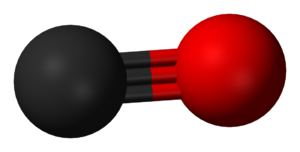Monoxide poisoning
| Carbon monoxide poisoning | |
|---|---|
| Synonyms | Carbon monoxide intoxication, carbon monoxide toxicity, carbon monoxide overdose |
 |
|
| Carbon monoxide | |
| Specialty | Toxicology, emergency medicine |
| Symptoms | Headache, dizziness, weakness, vomiting, chest pain, confusion |
| Complications | Loss of consciousness, arrhythmias, seizures |
| Causes | Breathing in carbon monoxide |
| Diagnostic method |
Carboxyl-hemoglobin level: 3% (nonsmokers), 10% (smokers) |
| Differential diagnosis | Cyanide toxicity, alcoholic ketoacidosis, aspirin poisoning, upper respiratory tract infection |
| Prevention | Carbon monoxide detectors, venting of gas appliances, maintenance of exhaust systems |
| Treatment | Supportive care, 100% oxygen, hyperbaric oxygen therapy |
| Prognosis | Risk of death 1 to 30%. |
| Frequency | >20,000 emergency visits for non-fire related cases per year (US) |
| Deaths | >400 non-fire related a year (US) |
| Classification | |
|---|---|
| External resources |
Carbon monoxide poisoning typically occurs from breathing in too much carbon monoxide (CO). Symptoms are often described as "flu-like" and commonly include headache, dizziness, weakness, vomiting, chest pain, and confusion. Large exposures can result in loss of consciousness, arrhythmias, seizures, or death. The classically described "cherry red skin" rarely occurs. Long term complications may include feeling tired, trouble with memory, and movement problems. In those exposed to smoke, cyanide toxicity should also be considered.
Carbon monoxide poisoning can occur accidentally or as an attempt to end one's life. CO is a colorless and odorless gas which is initially non-irritating. It is produced during incomplete burning of organic matter. This can occur from motor vehicles, heaters, or cooking equipment that run on carbon-based fuels. It can also occur from exposure to methylene chloride. Carbon monoxide primarily causes adverse effects by combining with hemoglobin to form carboxyhemoglobin (HbCO) preventing the blood from carrying oxygen. Additionally, myoglobin and are affected. Diagnosis is based on a HbCO level of more than 3% among nonsmokers and more than 10% among smokers.
...
Wikipedia
